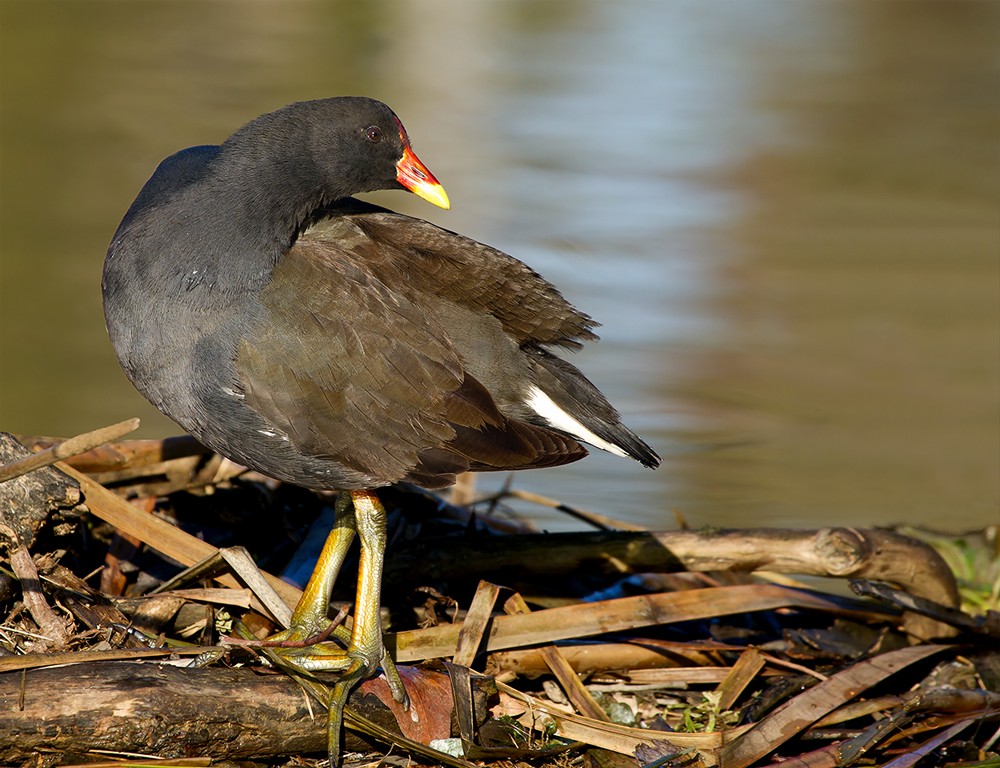Dusky Moorhen
A species of Moorhens Scientific name : Gallinula tenebrosa Genus : Moorhens
Dusky Moorhen, A species of Moorhens
Botanical name: Gallinula tenebrosa
Genus: Moorhens
Content
Description People often ask General Info
Description
The dusky moorhen is a medium size bird, slightly smaller than the purple swamphen. The New Guinea birds are smaller, at 25–32 centimetres (9.8–12.6 in) in length, than the Australian race 34–38 centimetres (13–15 in). Adult males generally weigh on average around 570 grams and adult females 493 grams. The adult dusky moorhen is mainly dark grey-black, with a browner tinge to the upper parts. It has a red frontal shield and yellow-tipped red bill like its Eurasian relative, but lacks the white flank line shown by common moorhen, and has orange-yellow rather than yellow legs. The Australian subspecies is larger and pager than both other subspecies. During autumn and winter, the colour of the frontal shield grows duller in females and young males. During the warmer months, in the breeding season, the shield grows brighter again in both sexes. 
Size
40 cm
Life Expectancy
1-3 years
Nest Placement
Floating
Feeding Habits
Dusky Moorhen consumes a varied diet including seeds, shrub and grass tips, algae, fruits, molluscs, and invertebrates, occasionally eating carrion and bird droppings. Foraging on land and water, dusky Moorhen adapts its feeding, providing chicks with annelid worms and molluscs, gradually introducing plants as they grow.
Habitat
Dusky Moorhen frequents freshwater wetlands like marshes and swamps, as well as brackish environments such as lagoons. Adapted to man-made waters, dusky Moorhen also inhabits reservoirs and urban park ponds. Their preferred habitat features open water edged with dense vegetation but excludes areas dominated by water hyacinth or mangrove ecosystems.
Dite type
Omnivorous
People often ask
General Info
Feeding Habits
Bird food type
Behavior
Breeding season is from August to January in the south of Australia, with generally one brood, and January to June in the north, often brooding twice. It is territorial when breeding, but otherwise gregarious. Dusky moorhens are diurnal, and roost at nighttime alone, in breeding groups, or in non-breeding flocks. The moorhens frequently flick their conspicuous white and black tail. This may be a signal of alertness or of social status, depending on the context. 
Distribution Area
It occurs in India, Australia, New Guinea, Borneo and Indonesia. Some vagrant, non-breeding birds may be found in New Zealand as well. In Australia, they are found all across the eastern states of Victoria, New South Wales and Queensland as far north as Cooktown, as well as the eastern part South Australia and the south-western tip of Western Australia. It is also found in parts of Tasmania and South Australia, but are uncommon. 
